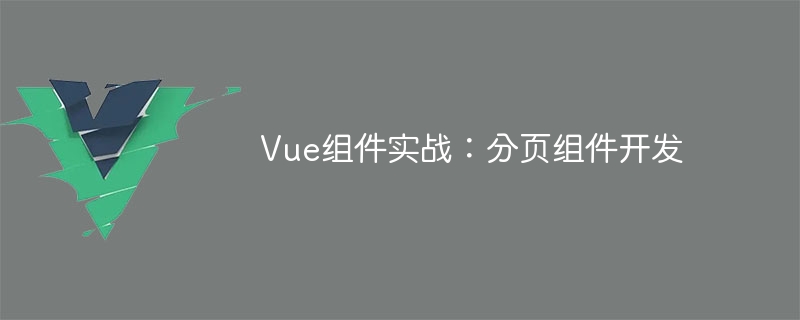所属分类:web前端开发

Vue组件实战:分页组件开发
介绍
在Web应用程序中,分页功能是必不可少的一个组件。一个好的分页组件应该展示简洁明了,功能丰富,而且易于集成和使用。
在本文中,我们将介绍如何使用Vue.js框架来开发一个高度可定制化的分页组件。我们将通过代码示例来详细说明如何使用Vue组件开发。
技术栈
开发环境
分页组件需求
设计思路和代码实现
根据需求,我们将分页组件拆分为多个小组件来实现。我们需要创建以下3个小组件:
主分页组件,负责分页数据和逻辑的处理。向子组件传递分页信息和响应子组件的事件。
该组件为按钮组件,用于创建分页按钮。
该组件用于创建单个页面块,包含页面标号和状态。页面块可以是当前页面或非当前页面。
接下来,让我们使用代码来实现以上3个组件。
<template>
<div class="pagination-container">
<button-prev :current="current" @onPrev="prev"></button-prev>
<page v-for="page in pages"
:key="page"
:page="page"
:is-selected="page === current"
@on-page-selected="selectPage"></page>
<button-next :current="current" :total="total" @onNext="next"></button-next>
</div>
</template>
<script>
import ButtonPrev from './ButtonPrev.vue';
import ButtonNext from './ButtonNext.vue';
import Page from './Page.vue';
export default {
components: { ButtonPrev, ButtonNext, Page },
props: {
total: {
type: Number,
default: 10
},
current: {
type: Number,
default: 1
},
maxShown: {
type: Number,
default: 5
},
prevText: {
type: String,
default: '上一页'
},
nextText: {
type: String,
default: '下一页'
}
},
computed: {
pages () {
const start = Math.max(1, this.current - Math.floor(this.maxShown / 2));
const end = Math.min(this.total, start + this.maxShown - 1);
return Array.from({ length: end - start + 1 }, (v, k) => start + k);
}
},
methods: {
selectPage (page) {
if (this.current === page) return;
this.current = page;
this.$emit('onPageChanged', page);
},
prev () {
if (this.current > 1) {
this.selectPage(this.current - 1);
}
},
next () {
if (this.current < this.total) {
this.selectPage(this.current + 1);
}
}
}
}
</script>上面的代码中,我们首先import了ButtonPrev、ButtonNext和Page组件。接着,用props方式获取了total, current, maxShown, prevText和nextText属性,并定义了计算属性pages,根据当前页码(current)和最大页码数(maxShown)得到一个包含页码数的数组,以在组件中呈现。
我们还定义了selectPage方法,在该方法中,如果页码(page)与当前页码(current)相同,则返回或不做任何事情。否则,将新页码发出给父组件。
prev()和next()方法用于处理上一页和下一页事件,并防止event被响应。
<template>
<button
class="btn-previous"
:disabled="current === 1"
@click="onPrev()">
{{ prevText }}
</button>
</template>
<script>
export default {
props: {
prevText: {
type: String,
default: '上一页'
},
current: {
type: Number,
default: 1
}
},
methods: {
onPrev () {
this.$emit('onPrev');
}
}
}
</script>
<style scoped>
.btn-previous {
border: none;
color: #333;
display: inline-block;
font-size: 16px;
padding: 6px 12px;
margin-right: 5px;
background-color:#fff;
cursor: pointer;
border-radius: 2px;
box-shadow: 0px 1px 3px rgba(0, 0, 0, 0.1);
}
.btn-previous:disabled {
color: #ccc;
cursor: default;
}
</style>上述代码中,我们首先通过props获取了当前页码(current)和上一页按钮的文本(prevText)属性。在模版中,使用类绑定(disabled)控制按钮使用状态。定义了一个onPrev方法,该方法触发父组件的onPrev事件。
<template>
<button
class="btn-next"
:disabled="current === total"
@click="onNext()">
{{ nextText }}
</button>
</template>
<script>
export default {
props: {
total: {
type: Number,
default: 10
},
nextText: {
type: String,
default: '下一页'
},
current: {
type: Number,
default: 1
}
},
methods: {
onNext () {
this.$emit('onNext');
}
}
}
</script>
<style scoped>
.btn-next {
border: none;
color: #333;
display: inline-block;
font-size: 16px;
padding: 6px 12px;
margin-left: 5px;
background-color: #fff;
cursor: pointer;
border-radius: 2px;
box-shadow: 0px 1px 3px rgba(0, 0, 0, 0.1);
}
.btn-next:disabled {
color: #ccc;
cursor: default;
}
</style>上述代码中,我们将ButtonPrev.vue的代码复制了一份,稍微改了一下文本和判断条件。
<template>
<button :class="{ current: isSelected }" class="btn-page" @click="onPageSelected(page)">
{{ page }}
</button>
</template>
<script>
export default {
props: {
page: {
type: Number,
required: true
},
isSelected: {
type: Boolean,
default: false
}
},
methods: {
onPageSelected () {
this.$emit('onPageSelected', this.page);
}
}
}
</script>
<style scoped>
.btn-page {
border: none;
color: #333;
display: inline-block;
font-size: 16px;
padding: 6px 12px;
margin-left: 5px;
background-color: #fff;
cursor: pointer;
border-radius: 2px;
box-shadow: 0px 1px 3px rgba(0, 0, 0, 0.1);
}
.btn-page.current {
background-color: #0078d7;
color: #fff;
}
</style>上述代码中,我们通过props获取了该页码的值(page)和按钮的isSelected属性。在模板中,使用类绑定("current")高亮显示选中的页面。
我们还定义了一个onPageSelected方法,该方法会触发父组件的onPageSelected事件。
最后,这些组件可以在任何Vue.js应用程序中的template中使用,如下所示:
<template>
<div>
<pagination
:total="total"
:current="current"
:maxShown="maxShown"
:prevText="prevText"
:nextText="nextText"
@onPageChanged="onPageChanged"></pagination>
<ul>
<li v-for="(item, index) in items" :key="index">{{ item.name }}</li>
</ul>
</div>
</template>
<script>
import Pagination from './Pagination.vue';
export default {
components: {
Pagination
},
data () {
return {
current: 1,
maxShown: 10,
prevText: '上一页',
nextText: '下一页',
total: 10,
pageSize: 10,
items: [{ name: 'Item 1' }, { name: 'Item 2' }, { name: 'Item 3' }]
}
},
methods: {
onPageChanged (page) {
console.log('Page changed to: ', page);
// 当前页面数据请求
}
}
}
</script>上述代码中,我们引入了Pagination组件,并将其作为template中的父组件。我们还将total, current和maxShown绑定到组件,以便获取到它们的值。在onPageChanged方法中,我们可以处理页面更改事件,并根据当前页码请求相应的数据。